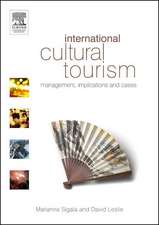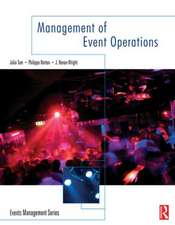Marketing Tourism Places (RLE Tourism): Routledge Library Editions: Tourism
Editat de Gregory Ashworth, Brian Goodallen Limba Engleză Paperback – 28 apr 2014
The contributors, from both academic institutes and the tourism industry, provide a multidisciplinary and professional analysis of what can be done to sell tourism places. Using both theoretical and empirical approaches, they give examples from different areas of the industry and evaluate different strategies a destination can adopt for maintaining and increasing its market share. All the contributors emphasize that selling tourism places must be a dynamic activity in which the place products are constantly monitored, so that they can be revitalized, repositioned, or renewed in the market context.
| Toate formatele și edițiile | Preț | Express |
|---|---|---|
| Paperback (1) | 493.73 lei 43-57 zile | |
| Taylor & Francis – 28 apr 2014 | 493.73 lei 43-57 zile | |
| Hardback (1) | 825.06 lei 43-57 zile | |
| Taylor & Francis – 5 dec 2012 | 825.06 lei 43-57 zile |
Preț: 493.73 lei
Nou
Puncte Express: 741
Preț estimativ în valută:
94.47€ • 98.90$ • 78.17£
94.47€ • 98.90$ • 78.17£
Carte tipărită la comandă
Livrare economică 07-21 aprilie
Preluare comenzi: 021 569.72.76
Specificații
ISBN-13: 9781138007659
ISBN-10: 113800765X
Pagini: 314
Dimensiuni: 174 x 246 x 18 mm
Greutate: 0.56 kg
Ediția:1
Editura: Taylor & Francis
Colecția Routledge
Seria Routledge Library Editions: Tourism
Locul publicării:Oxford, United Kingdom
ISBN-10: 113800765X
Pagini: 314
Dimensiuni: 174 x 246 x 18 mm
Greutate: 0.56 kg
Ediția:1
Editura: Taylor & Francis
Colecția Routledge
Seria Routledge Library Editions: Tourism
Locul publicării:Oxford, United Kingdom
Public țintă
General, Postgraduate, Professional, and UndergraduateCuprins
1. Can Places Be Sold For Tourism? 1. Theory and Concept 2. The Concept of Opportunity Sets As A Methodological Framework For The Analysis Of Selling Tourism Places: The Industry View 3. People, Places and Priorities: Opportunity Sets And Consumers' Holiday Choices 4. Opportunity Sets As Analytical Marketing Investments: A Destination Area View 5. Hedonic Prices And The Marketing Of Package Holidays: The Case Of Tourism Resorts In Malaga 6. Strategies For Tourism Destination Development: An Investigation Of The Role Of Small Businesses 2. Shaping The Product 7. Leisure + Shopping = Tourism Product Mix 8. The Historic Cities Of Groningen: Which Is Sold To Whom? 9. The Tourist Destination As Product: The Case Of Languedoc 10. Destinations – As Marketed In Tour Operators' Brochures 3. From Product To Organisation 11. The Organisation Of Tourism In Austria: Marketing At The Provincial Level 12. Place Promotion By Tourist Boards: The Example Of 'Beautiful Berkshire' 13. Research Into Tourism Markets: Some Frisian Experiences 14. Marketing Through Travel Agencies 4. Selling Tourism Places 15. The Dynamics Of Tourism Place Marketing. Index.
Notă biografică
Multivolume collection by leading authors in the field
Descriere
This book, originally published in 1990, explores how destinations invest increasing amounts of time and money into developing and promoting their 'products'.
The contributors, from both academic institutes and the tourism industry, provide a multidisciplinary and professional analysis of what can be done to sell tourism places. Using both theoretical and empirical approaches, they give examples from different areas of the industry and evaluate different strategies a destination can adopt for maintaining and increasing its market share. All the contributors emphasize that selling tourism places must be a dynamic activity in which the place products are constantly monitored, so that they can be revitalized, repositioned, or renewed in the market context.
The contributors, from both academic institutes and the tourism industry, provide a multidisciplinary and professional analysis of what can be done to sell tourism places. Using both theoretical and empirical approaches, they give examples from different areas of the industry and evaluate different strategies a destination can adopt for maintaining and increasing its market share. All the contributors emphasize that selling tourism places must be a dynamic activity in which the place products are constantly monitored, so that they can be revitalized, repositioned, or renewed in the market context.





















